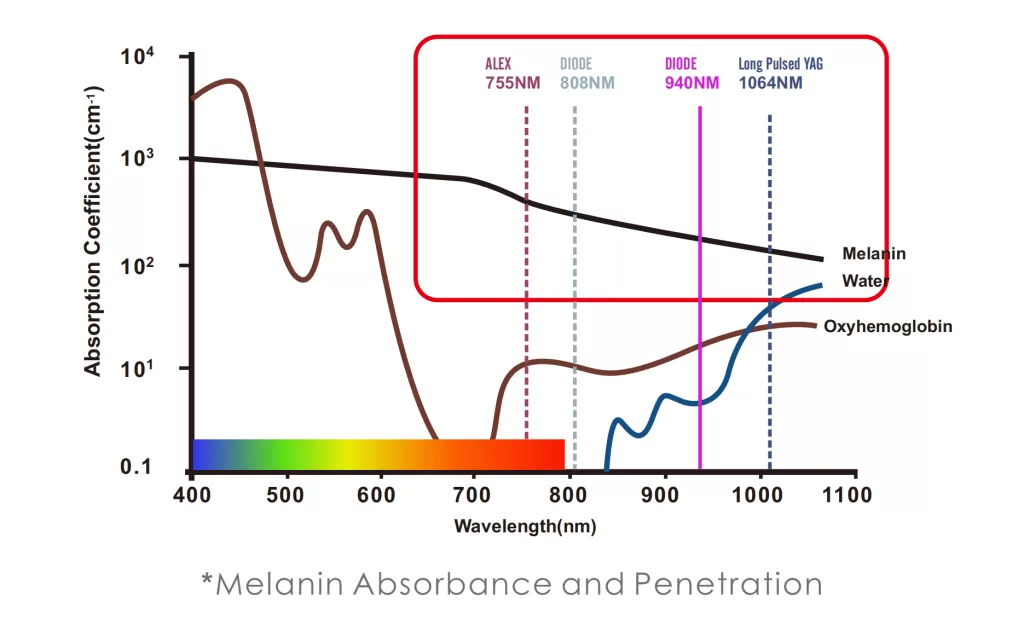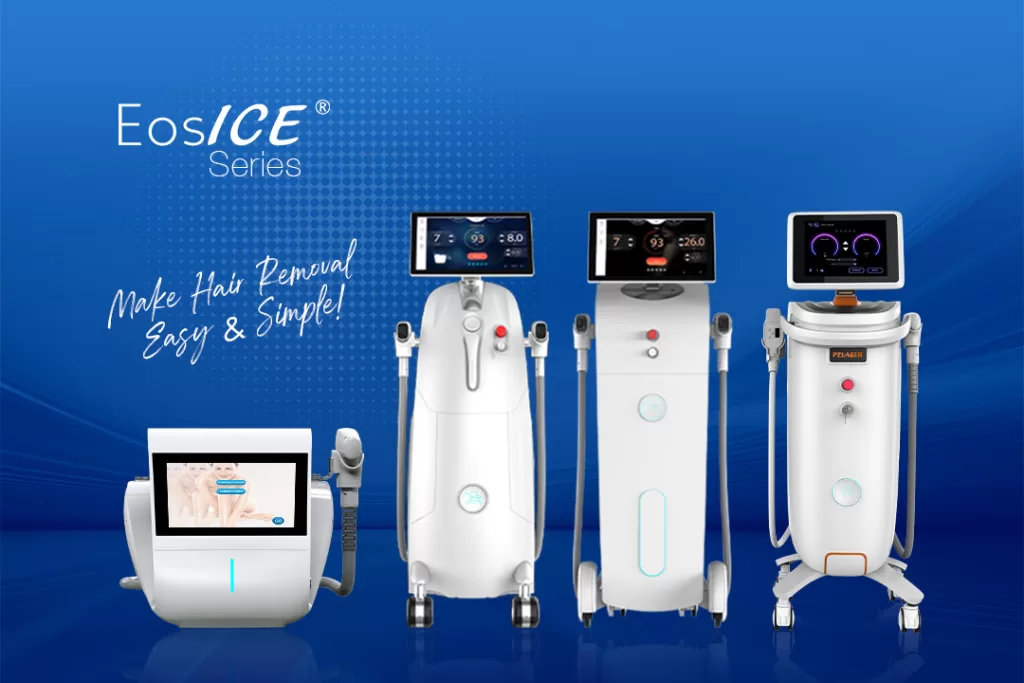Introduction
The laser hair removal market is flooded with different types of lasers, but what are the differences in their wavelengths? What sets high-performance laser machines apart isn’t just their brand or build quality; it's the laser wavelength. Understanding the differences between 755nm, 808nm, and 1064nm wavelengths and how each wavelength interacts uniquely with melanin and the skin layers will impact efficacy and safety. In this comprehensive guide, you'll discover the science behind each wavelength and how to determine the best hair removal machine for your clinic or medspa. Whether you're new to lasers or looking to upgrade, this is the roadmap to smarter investment and better outcomes.
Understanding Laser Wavelengths: 755nm, 808nm, 1064nm

Laser wavelengths define how deeply a beam penetrates the skin and how selectively it targets melanin in hair follicles. The number (755, 808, or 1064) represents the light wavelength in nanometers (nm), determining how the energy interacts with the skin.
- Shorter wavelengths (Alexandrite 755nm): Absorb more easily into melanin, making them excellent for lighter skin and fine hair.
- Medium wavelengths (Diode 808nm): Offer a balance between depth and absorption, ideal for a wider range of clients.
- Longer wavelengths (Long-pulsed YAG 1064nm): Penetrate deeper and bypass melanin-rich skin layers, making them safe for darker skin tones.
The Fitzpatrick scale, which categorizes skin by pigmentation and sun response, is often used to select the appropriate laser. Choosing the right wavelength mitigates risks such as burns, hyperpigmentation, or inefficiency.
Comparing 755nm vs 808nm vs 1064nm Laser Machines
1. 755nm Alexandrite Laser Machine
The 755nm Alexandrite laser machine delivers high melanin absorption and shallow penetration. It is:
- Perfect for Fitzpatrick I-III (light to medium skin tones)
- Highly effective on fine or light-colored hair
- Known for faster treatment speeds due to its high pulse repetition
Pros & Cons:
- Pros: It targets light, shallow hair follicles effectively to deliver quick results with fewer sessions.
- Cons: It has a higher chance of side effects like hyperpigmentation or burns. It's not recommended for darker skin tones.
2. 808nm Diode Laser Machine
The 808nm diode laser hair removal machine is considered the workhorse of the industry. This wavelength strikes a balance between safety and efficacy.
- Suitable for Fitzpatrick I-V
- Effective on medium to coarse hair types
- Penetrates deeper than 755nm but retains moderate melanin absorption
Pros & Cons:
- Pros: It's widely adaptable across skin tones, which produces stable performance with excellent results.
- Cons: It's less effective on very fine or light hair.
3. 1064nm Nd:YAG Laser Machine
The Nd:YAG 1064nm laser machine is specifically engineered for darker skin types. It has:
- Deepest penetration among the three wavelengths
- Lowest melanin absorption, minimizing risk for Fitzpatrick IV-VI
Pros & Cons:
- Pros: It's the safest option for dark skin. It can reach deep follicles like the underarms or the bikini area.
- Cons: It may require more sessions for complete results. But it's not ideal for light or fine hair.
Comparison Table: 755nm vs 808nm vs 1064nm Laser Technologies
| Feature | 755nm (Alexandrite) | 808nm (Diode) | 1064nm (Nd:YAG) |
|---|---|---|---|
| Penetration Depth | Shallow | Medium | Deep |
| Melanin Absorption | High | Moderate | Low |
| Skin Type | I–III | I–V | IV–VI |
| Hair Type | Fine | Medium | Coarse |
| Safety for Dark Skin | Low | Moderate | High |
| Treatment Speed | Fast | Balanced | Slower |
Single Wavelength vs Triple Wavelength Laser Machines: Which One Is Better?
Single Wavelength vs Triple Wavelength Laser Machines
Single-wavelength machines are best for clinics that cater to a consistent clientele with similar skin types and hair characteristics, as they are generally more affordable upfront, simpler to operate for targeted treatments, and well-suited for beginners or niche service providers.
However, the downside is their limited versatility. In contrast, triple-wavelength machines (755nm + 808nm + 1064nm) offer a broader treatment capability for all skin and hair types. It will reduce the need for multiple devices and provide a faster ROI due to higher client turnover.
Why Triple-Wavelength Technology Is the Future of Laser Hair Removal
The aesthetics industry is shifting toward versatile, intelligent solutions. Triple-wavelength diode systems are leading the charge due to their ability to treat all Fitzpatrick skin types (I-VI) safely and effectively. Such systems can customize treatments for specific hair thickness and depth and reduce treatment time by combining three wavelengths in one session. It will also improve patient comfort and satisfication due to tailored energy absorption.
These devices eliminate the guesswork, offering more predictable outcomes and greater safety, which is crucial in competitive markets. For multi-ethnic communities or clinics expanding services, a triple-wavelength diode laser hair removal machine is a future-proof investment.
How to Choose the Right Wavelength for Your Clinic or Clients
The right laser wavelength for hair removal depends on a variety of factors, such as skin tone, hair color, and cost. Each laser has its own unique characteristics, and understanding these factors can help you target a specific population, ensuring a safe and effective treatment. Before investing in a diode laser hair removal machine, consider these factors:
1. Skin Types Served
For optimal results, clinics should match laser wavelengths to skin tones: 755nm is best for light skin types (Fitzpatrick I–III), 808nm suits medium tones (Fitzpatrick III-IV), and 1064nm is the safest and most effective choice for dark skin (Fitzpatrick V–VI).
2. Hair Type
When it comes to hair texture, 755nm is ideal for treating fine hair, 808nm works well on medium to coarse hair, while 1064nm is best suited for coarse, deep-rooted hair. The triple-wavelength laser is a more advanced version of the single hair removal laser, whose combination enables effective hair removal across various hair types.
3. Business Goals
A triple-wavelength system ensures flexibility and growth. While s single-target machine may suffice for a small treatment scope. Customers seeking fast and efficient results tend to choose machines that combine multiple wavelengths to meet their treatment goals and reduce the number of touch-up treatments.
4. Budget & ROI
Triple-wavelength systems significantly reduce long-term operational costs by combining the functionality of three individual lasers into a single device. This eliminates the need for purchasing and maintaining multiple machines for different skin types and hair textures, streamlines treatment protocols, and minimizes technician training time. For clinics aiming to maximize space, efficiency, and return on investment, a triple-wavelength system is designed to enhance service range while lowering overhead.
5. Space Constraints
A single, multi-use laser system takes up considerably less physical space than housing three separate machines for each wavelength. This compact design is especially beneficial for clinics with limited treatment rooms, allowing for a more streamlined and professional setup. It not only improves workflow efficiency but also creates a clutter-free environment that enhances both practitioner comfort and client experience.
PZLASER's EosICE® Hair Removal Laser Machine: Your All-in-One Solution

When precision meets versatility, the result is the EosICE® Laser Hair Removal System. Engineered by PZLASER, this advanced platform combines 755nm, 808nm, 940nm, and 1064nm wavelengths into one system, allowing clinics to tailor every session to the patient’s unique needs.
The EosICE® laser hair removal machine stands out with its advanced quad-wavelength technology, delivering 755nm, 808nm, 940nm, and 1064nm either simultaneously or selectively for precise treatments. Its real-time 4 way cooling system ensures maximum comfort and safety even on sensitive skin, while high-speed pulse repetition shortens session times without sacrificing efficacy. A smart interface with built-in presets streamlines operation, and FDA and CE certifications guarantee compliance with global safety standards.
From a business perspective, the EosICE® brand is trusted worldwide. It treats all skin tones and hair types with a single device, significantly reducing equipment and maintenance expenses. By increasing treatment versatility and efficiency, it helps clinics expand service capacity and revenue, all while building trust with clients who expect high-performance, personalized results.
FAQs About 755nm vs 808nm vs 1064nm Laser Machines
Q1: Which wavelength is safest for dark skin tones?
A: The 1064nm laser is safest, as it penetrates deeply without targeting melanin in the epidermis.
Q2: Can one machine treat all skin types and hair textures?
A: Yes, a triple-wavelength diode system can handle everything from fine facial hair to coarse body hair on any skin tone.
Q3: How many sessions are needed per wavelength?
A: Most treatments require 6-8 sessions, though this varies by hair density, color, and the laser used.
Q4: Is triple-wavelength technology more expensive?
A: Yes. But it's more cost-effective in the long run due to reduced maintenance, broader application, and increased revenue.
Q5: What certifications should I look for in a hair removal device?
A: Devices should be FDA-approved, CE-marked, and backed by clinical research or manufacturer support.
Conclusion
Understanding the nuances between 755nm vs 808nm vs 1064nm laser machines is essential for selecting the best hair removal machine. Each wavelength brings distinct advantages and limitations, shaped by skin type, hair type, and clinical goals.
For clinics wanting unmatched versatility, efficiency, and safety, EosICE® triple-wavelength systems represent the gold standard. Investing in this technology that adapts to every client, clinics can future-proof their services and elevate client satisfaction.






